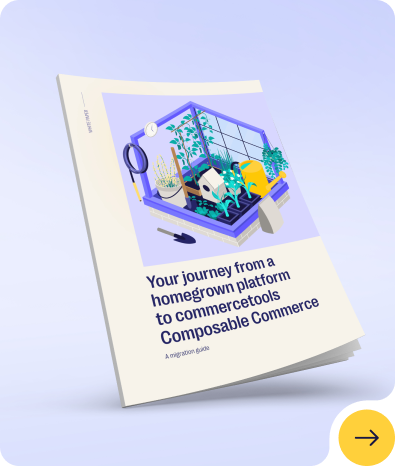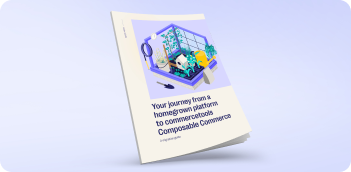Your last replatform. Ever.
Break free from legacy systems that stall your growth and innovation. Leading enterprises are choosing commercetools to modernize their commerce infrastructure with flexibility, speed and scale.
TALK TO AN EXPERT
Stuck in a monolithic platform? We can help.
If your current commerce system struggles during peak demand, is expensive to maintain or limits innovation, it's time to rethink your tech stack.
commercetools Composable Commerce gives you a modern, modular foundation for building fast, scaling easily and adapting continuously — without disrupting operations.
How commercetools differentiates from legacy platforms.
Legacy commerce platforms | commercetools |
Inflexible and slow to change | Flexible and fast |
Scalability bottlenecks | Elastic scalability |
High maintenance complexity | Low operational overhead |
Hidden costs everywhere | Lower TCO |
Growth-limiting. | Built to scale |
Replatforming from homegrown to composable
Homegrown systems may have served you well, but as your business grows, maintaining custom code becomes costly, complex and limiting. With commercetools, you can:
- Replace brittle, aging code with proven, scalable components.
- Eliminate hidden costs of upkeep and security.
- Free your teams to innovate, not troubleshoot.
- Future-proof your stack with API-first flexibility.

Dream big. Start small. Deliver faster.
Start with a pilot or MVP to reduce risk, prove value and accelerate results.
7 weeks
Jaycar
2 months
ARK Bokhandel
4 months
Tekton
Thanks to smooth integration with commercetools, we’ve also been able to improve time to value, significantly.
VP of Engineering, Moonpig

Speed up your migration with pre-composed solutions.
Cut down implementation time by 30% with commercetools Foundry.
For B2C Retail
Deliver seamless omnichannel experiences with a retail-specific blueprint built for high volumes, promotions, and personalization.
Explore
For B2B Manufacturing
Streamline complex procurement flows with out-of-the-box capabilities for manufacturers to build eCommerce with confidence.
Explore
Choose the next step to start your commercetools journey
Frequently asked questions
How can enterprises migrate to composable commerce?
There are two main methods of migrating to a composable commerce platform: The phased approach (strangler pattern) and the big bang approach.
The phased approach allows you to gradually replace monolithic functions with individual components, minimizing risk and disruption. In contrast, the big bang approach involves building the new system from scratch and switching over all at once, which can be beneficial for platforms that are difficult to break down.
So, what’s the best approach for your business? It’s entirely up to you. Consider how easily your current system can be broken down into smaller components, how experienced your team is with microservices, and whether it makes sense to create a proof-of-concept (POC) and pilot it with a subset of your buying journey. Answering these questions will help you define what’s the migration process that fits the needs of your business.
What are the best practices for a smooth migration process?
1. Accelerate time to value with pre-composed solutions
Use pre-composed solutions with pre-configured components and best practices instead of building from scratch. commercetools Foundry Blueprint for B2C Retail and B2B Manufacturing provides ready-to-use integrated components that allow for flexibility and customization without the typical years-long implementation timelines.
2. Leverage pre-built integrations
Pre-built integrations actually speed up time to market. commercetools Connect offers three options: Ready-to-use connectors (no code changes needed), enhanced low-code options for customization, and fully custom connectors for unique requirements like CPQ and ERP systems.
3. Ensure robust data management
Flexible data models in composable commerce let you handle multiple data scenarios and attributes without affecting performance. GenAI can also help with data hygiene and product data restructuring.
4. Empower business teams without developers
The Merchant Center provides no-code tools so marketers, content managers and product teams can create promotions, manage discounts and set up new sales channels without depending on tech teams.
5. Take an incremental approach for your implementation
Start with a smaller scope, like digitizing your product catalog and checkout, then gradually add components. This MVP approach reduces risk and creates a cycle of release-learn-iterate rather than trying to build everything from day one.
6. Tap into experienced partners and accelerators
Leverage implementation partners and accelerators throughout your journey. A vast network of solution partners helps expedite timelines and provides ongoing support for both small improvements and major innovation initiatives.
What are the main steps to migrate to composable commerce?
1. Start with discovery and gap analysis
Assess your current tech stack, from frontend to backend and third-party systems. Identify pain points, redundant features and what’s missing. Prioritize what must be migrated, replaced or left behind.
2. Build a strategic migration roadmap
Define your ideal business state and map out the path to get there. Include key areas like data, frontend and integrations. Assign roles and timelines to keep the process organized and on track.
3. Clean, structure and migrate your data
Identify the most valuable data, such as catalog, customer, and order history. Clean, enrich and model it for flexibility. Use commercetools' APIs to migrate data efficiently, with full backups in place.
4. Customize behavior with API extensibility
Tailor the platform to your business using commercetools' 500+ APIs. Extend core functionalities, create custom workflows and build unique experiences that align with your operations.
5. Integrate additional best-of-breed services
Build your ideal tech stack with APIs. Add systems like ERP, payments, CMS, search and personalization tools. With composable architecture, you’re free to choose what works best without vendor lock-in.
6. Connect and evolve the digital storefront
Choose a decoupled frontend that fits your needs or use commercetools Frontend. Redesign your storefront for better UX, speed and flexibility. Integrate it seamlessly with your backend.
7. Extend to in-store and unify commerce
If you have physical stores, unify online and offline operations with commercetools InStore. Sync inventory, customer data and workflows across all channels from one backend.
8. Test, deploy and continuously improve
Run rigorous testing at every stage — load, integration and performance. Monitor KPIs like page speed and transaction success. Post-launch, optimize based on real data and customer behavior.
What benefits have enterprises reaped after migrating from legacy platforms to commercetools?
Enterprises migrating to commercetools have achieved measurable business growth through improved flexibility, scalability and operational efficiency:
Adelco increased eCommerce sales by 400% and boosted conversion rates by 20% with their hybrid sales approach for B2B buyers.
APG & Co. cut technology costs by 35% and reduced technical support time by 60% after leaving Salesforce.
ARK Bokhandel achieved 25% revenue growth in the first month and improved conversion rates from 4-5% to 7-14%.
BIC streamlined digital operations and opened new revenue streams while maintaining its quality standards.
Jaycar unified online and in-store experiences with consistent, tailored shopping across all channels.
Wild Fork Foods saw 58% more daily orders and 73% increase in new customers on launch day after migrating from Shopify.
Why should enterprises migrate from homegrown platforms to composable commerce?
Many enterprises built custom platforms in-house years ago, but as businesses scale, these homegrown solutions often become liabilities. Here’s how leading enterprises transformed their operations by migrating to commercetools:
Moonpig: From monolith to rapid innovation
Their homegrown, custom-built platform became a bottleneck for growth. After switching to commercetools, Moonpig accelerated feature delivery and now scales effortlessly during peak periods like Christmas and Mother’s Day.
Interflora UK: 20 years of tech debt cleared in 9 months
In less than a year, Interflora migrated off two decades of legacy infrastructure. With commercetools, they cut hosting costs by 20% and moved to biweekly sprint releases on a modern SaaS foundation.








